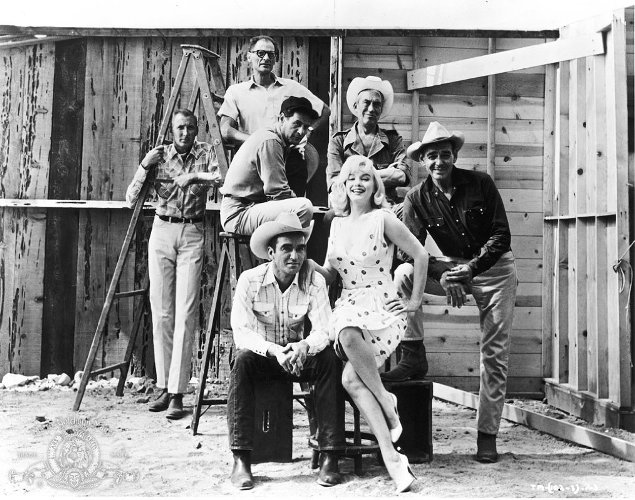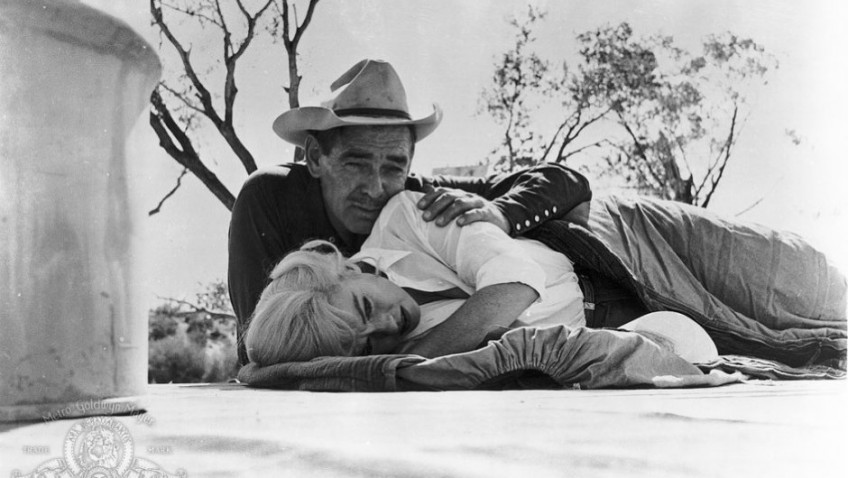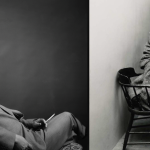Opening in selected cinemas nation wide to coincide with the Marilyn Monroe retrospective at the BFI this month.
That The Misfits was released in 1961 as a magnificent looking two-hour movie is, in itself, extraordinary; that it turned out to be a masterpiece is a miracle. The release of the film, and its reputation today, was, and has been, overshadowed by real-life drama going on during production and the film struggled to break even. Now we can return (and younger generations can encounter) The Misfits with fresher eyes, focusing on the depth of the characters; the great performances from each of the five central characters; and an emotionally-charged, climactic final mustang roping scene, that still, in this age of CGI marvels, remains a cinematic tour de force.
The dysfunctional characters and fraught relationships within the film were matched by what was going on in real life on the set. Montgomery Clift was reportedly suffering from alcohol and prescription drug addiction following his serious car accident. Marilyn Monroe, also suffering from prescription drug abuse, was frequently late or absent until production halted altogether when she was taken to a hospital for detox. Director John Huston spent nights gambling and drinking, while the author of the brilliant script, Arthur Miller, was embroiled in on-set arguments with his wife, Marilyn Monroe. All of this was compounded by the 42 degree heat of the Nevada desert in summer.
Within 10 days of completion of principal photography 59-year-old Clark Gable, who had performed his own stunts on the shoot, was dead from a heart attack. His leading lady, Monroe, died just under two years later, aged 36. Within six years Montgomery Clift was dead following a heart attack at the age of 45. Ritter died of a heart attack three years after him at age 66.
 What they left on celluloid is the story of Roslyn Tabor (Monroe), a stunning 30-ish dancer who is staying with an older friend, Isabelle Steers (Thelma Ritter) in Reno, Nevada: capital of the quickie divorce. As we watch the two fun-loving, hard drinking women together, we realise that Isabelle, an old hand at divorce, is what Roslyn will become if her life is not transformed.
What they left on celluloid is the story of Roslyn Tabor (Monroe), a stunning 30-ish dancer who is staying with an older friend, Isabelle Steers (Thelma Ritter) in Reno, Nevada: capital of the quickie divorce. As we watch the two fun-loving, hard drinking women together, we realise that Isabelle, an old hand at divorce, is what Roslyn will become if her life is not transformed.
Widower and former cowboy Guido (Eli Wallach), now an auto mechanic, is attending to Isabelle’s beat up car. Explaining the car problem, Isabelle says: ‘It’s the darn men. They’re banging into the car just to start a conversation.’ When Guido is introduced to Roslyn he understands exactly what she means.
Celebrating Roslyn divorce at a local bar, the women run into Guido who introduces Roslyn to his best mate, cowboy and drifter Gay Langland (Gable). The foursome go out to a semi-abandoned house that Guido had started to build for his late wife, but the boozy party is cut short when Roslyn is taken ill.
Soon after, Gay and Roslyn, now a couple, move into Guido’s house and fix it up. Gay even speaks of having a child but Roslyn remains silent on the subject. Wishing to share an important part of his life with Roslyn, Gay wants to show Roslyn a rodeo, although it is already apparent from an argument about killing rabbits that Roslyn hates any kind of cruelty and violence. Before the rodeo Roslyn is introduced to Gay’s friend Perce Howland (Montgomery Clift) who, despite planning to make some money in the rodeo, has been heavily drinking. When Roslyn is forced to watch Perce thrown from a bull after suffering head injuries on a bucking horse, she is horrified and rushes to his aid.
Roslyn’s relationship with all three men shifts throughout the film, as our perceptions of the men continually change. The men cannot figure out if she is a dizzy blond bimbo or a wise seer. The truth of each man’s character emerges during the long, tense, and authentically-captured mustang roping scene when Roslyn searches for an ally to stop the cruelty. The script is the story of a gradual reckoning not only for Roslyn, but particularly for the three men stuck in their illusory worlds. Even a defiantly determined Gay has to evaluate the anachronistic mustang pursuit when he learns that the horse count, once in the hundreds, is now down to six, including a mother and colt. In Roslyn’s presence, what once seemed like sport is now tainted.
This being a script by Arthur Miller (the symbolic mustangs are not the only ‘misfit animals’) you get these great Hollywood stars at their best and poetry, too. ‘You have so much trust in your eyes. It’s like you were just born,’ Perce tells Roslyn. Drawing an analogy with Roslyn’s nightclub dancing, which society discredits and turns into something dirty, Gay tells Roslyn that the mustang roping ‘is how I dance.’ Referring to the butchers, he argues, ‘if they do something different with it, I can’t help it.’
There are instances when Miller’s writing, which would sound perfect on stage, sounds a bit heavy on film, but there are few scripts around today that can compare for intelligence, characterisation, intensity and beauty.
The Misfits will be in selected cinemas from 12 June as part of the Marilyn Monroe season at the BFI running. This, Monroe’s final film, exquisitely shot in black & white by Russell Metty, shows that for all her problems, Monroe’s gift for comedy was matched by her dramatic acting right to the end of her life.
Joyce Glasser




